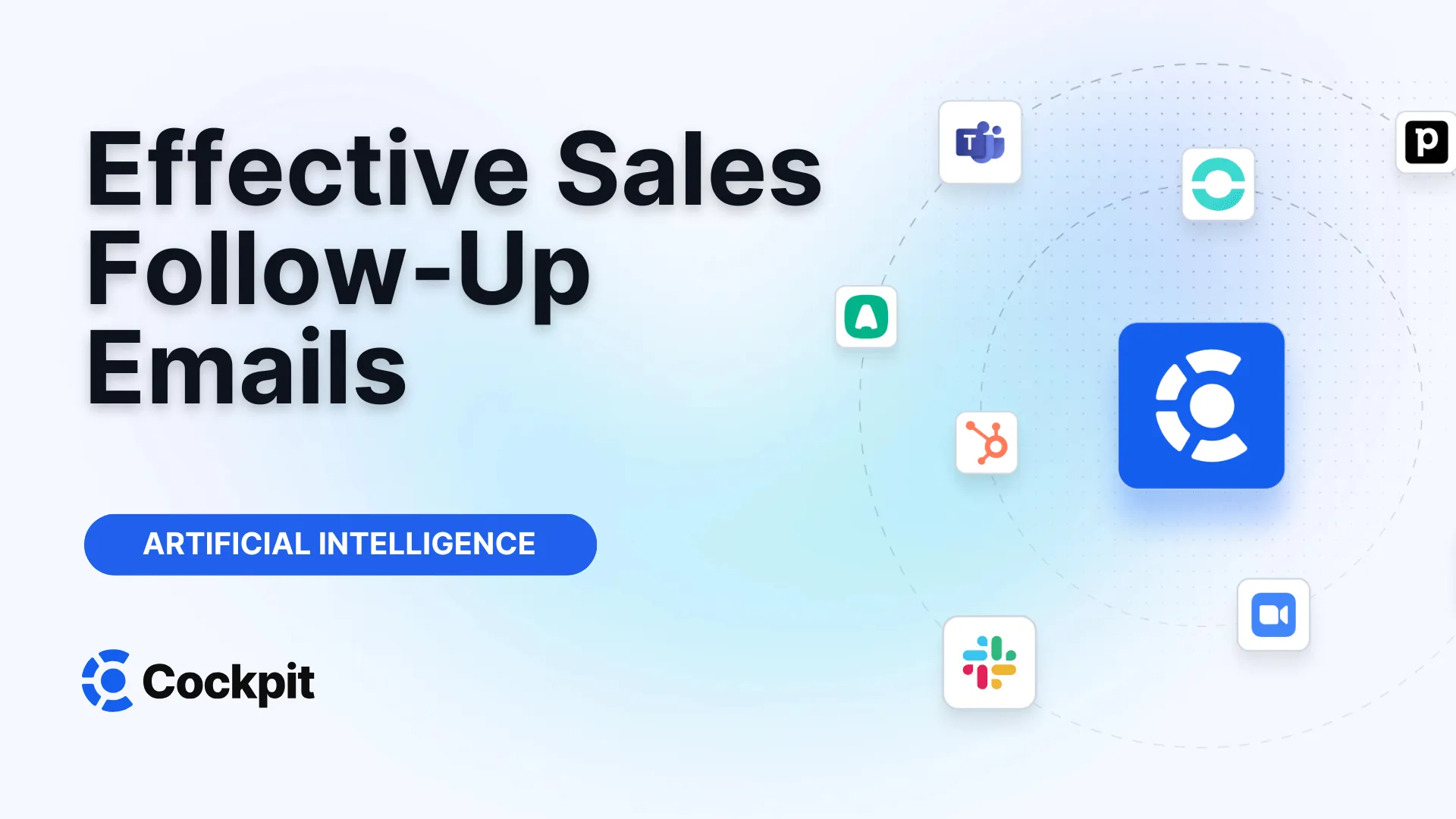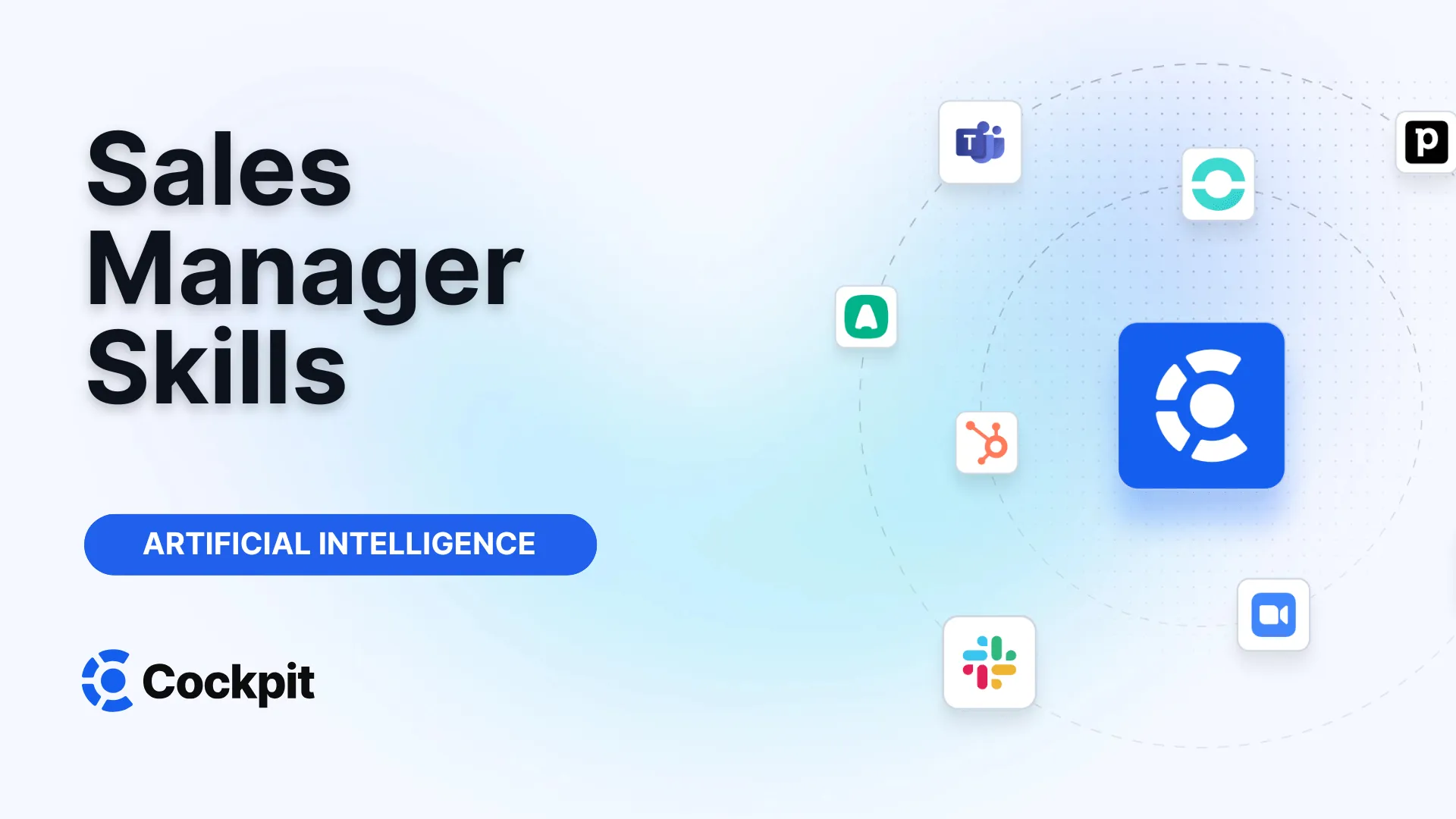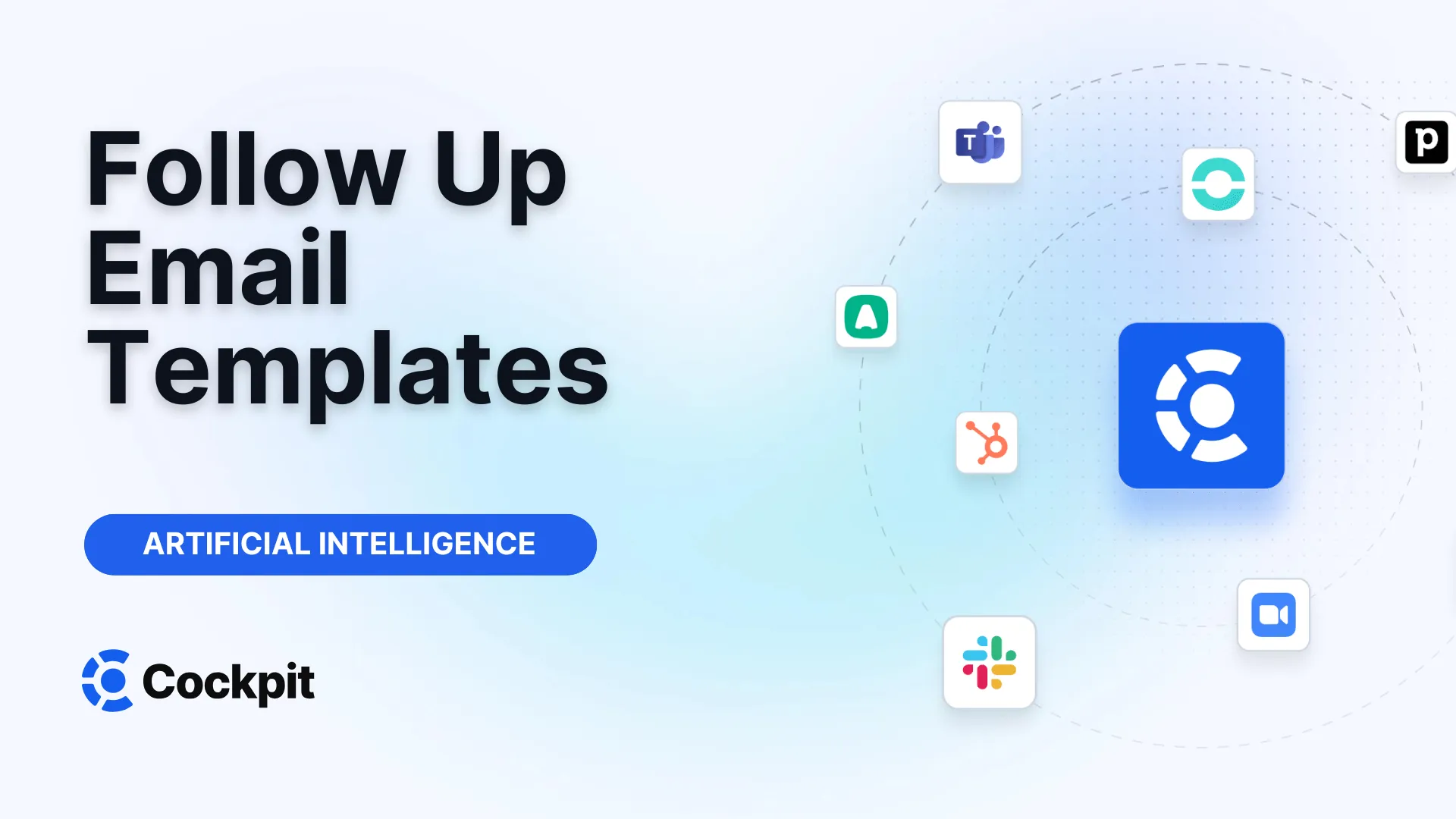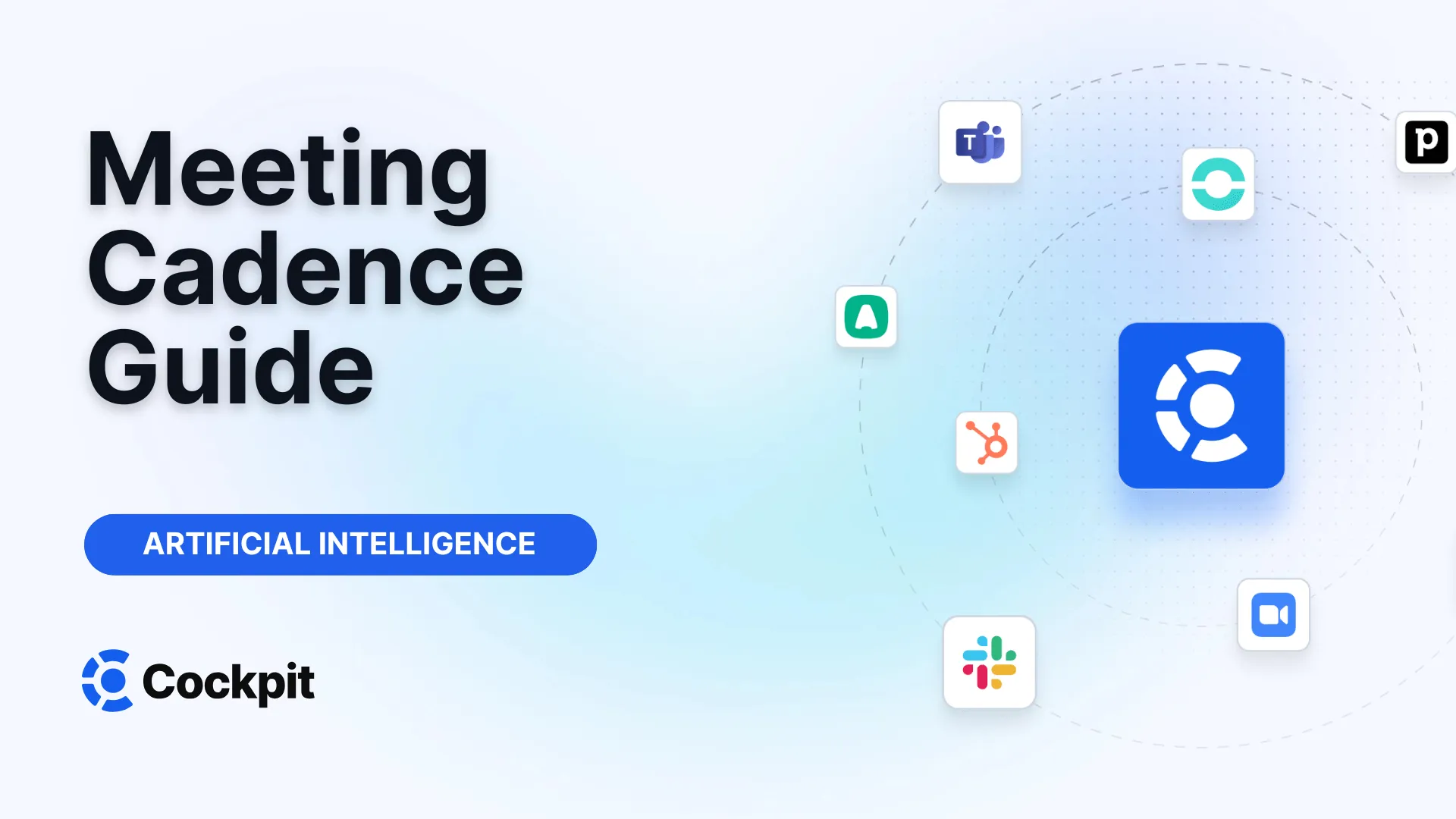Optimize your sales force in just a few clicks

Thousands of sales teams boost their performance with Cockpit. Why shouldn't you?
Explore CockpitSummary
Absolutely. Here is a proposed article optimized for the keyword "sales follow up email examples," respecting all your instructions and integrating the information provided about your company.
Are you tired of emails that start with "Just wanted to check in..." and end up straight in the trash? You are not alone. Do you feel like you’re leaving money on the table every time you send a generic, soulless follow-up? How can you transform these follow-ups, often seen as a chore, into real sales opportunities? What if you had proven templates for every situation, enabling you to stay relevant, provide value, and ultimately close more deals?
This is exactly what we will explore. Get ready to discover effective follow-up techniques, concrete examples, and expert tips so that every follow-up email becomes a constructive conversation with your prospects.
Why is the sales follow-up email an essential sales lever?
A sales follow-up email is much more than a simple reminder. It is a message you send after an interaction with a prospect with the aim of continuing the conversation and strengthening the relationship. Its ultimate goal is, of course, to close a sale, but its immediate role is to maintain the connection and move the prospect along their buying journey. The content of this email varies drastically depending on your contact’s needs, interests, and behavior. Sometimes it will be about educating a prospect on your brand; other times, about proposing a clear next step or submitting a commercial proposal.
Email is a fast and practical follow-up method. It allows you to transmit information efficiently, leaving the prospect free to reply at their convenience. This approach, often seen as less intrusive than a phone call, respects your contacts’ busy schedules and is therefore particularly effective. It’s the art of staying present in their mind without being overwhelming.
The anatomy of the perfect follow-up email
Before diving into the templates, it is essential to understand the typical structure that makes a follow-up email effective. Think of it as a recipe with four simple but powerful steps.
- Intent and recap: Always start by stating the reason for your email. Briefly remind the context of your last conversation or the specific needs of their company you identified. This shows you listened and that your approach is thoughtful.
- Value provision: This is where you differentiate yourself. Position yourself as an expert who understands your prospect’s challenges and genuinely wants to help. Share a relevant article, a case study, or a whitepaper that frames your solution as an answer to their problems. The goal is to align this resource with the needs expressed during your previous exchange.
- Call to action (CTA): Propose a clear and singular next step. Your CTA should encourage the prospect to act and keep the momentum. Whether it’s scheduling a call, a demo, or answering a question, be precise and direct.
- Email subject line: Strangely, this comes last. Why? Because the content of your message often dictates the best possible subject. Save this task for the end and strive to create a subject line that stands out in a crowded inbox.
One of the biggest challenges for salespeople is remembering the precise details of each conversation to write relevant follow-ups. That’s where tools like Cockpit come in. By automatically recording, transcribing, and summarizing your calls, our platform provides you with a perfect recap to include in your email, ensuring you never forget a key point.
5 Follow-up email templates for every sales situation
Never start from a blank page again. Use these follow-up email examples as a base, but always personalize them for each prospect. The secret is to capture attention amidst hundreds of other solicitations.
1. After an event (trade show, conference, networking)
Trade shows and conferences are gold mines for meeting prospects. Right after an interesting discussion, take some notes on their business card. Within the following week, continue the conversation with a personalized email.
| Email Template: Personalized Follow-Up After Event |
|---|
Subject: [Their Company Name] <> [Your Company Name] Hello [First Name], It was a pleasure to speak with you at [Event Name]. Thank you for taking the time to [visit our booth / discuss your project]! I remember you mentioned your challenge concerning [reference a specific point from the conversation: a challenge, goal]. I immediately thought of [relevant resource: article, case study] that might interest you. It illustrates how we help our clients [solve the mentioned problem]. Would you be available for a short 15-minute call next week to discuss this in more detail? Looking forward to our conversation, |
Why does it work?
- Personalized and thoughtful: It shows that you were attentive.
- Memory aid: It refreshes your prospect’s memory about who you are.
- Value provision: Linking a conversation detail to a solution demonstrates your expertise and willingness to help.
- Clear CTA: The next step is simple and easy to accept.
Other subject line ideas:
- Following up on our discussion at [Event Name]
- An idea for your [mentioned challenge]
- Can we be honest? (Use with a bold email body that breaks a myth related to their industry, e.g., “Most companies think [XYZ] is the solution, but I discovered that [your approach] is much more effective. Here’s why…”)
2. After a conversation or demo
This is arguably the most crucial follow-up. You must send an email within 24 hours following a discovery call or demo. The goal is to recap, confirm next steps, and maintain momentum.
| Email Template: Post-Conversation/Demo Follow-Up |
|---|
Subject: Summary of our discussion and next steps Hello [First Name], Thank you again for your time today. I really enjoyed learning more about [Their Company Name] and your goals regarding [main discussed objective]. As agreed, here is a brief summary of the key points we covered: To assist you in your decision-making, here is [link to an additional resource, e.g., a case study from the same industry]. Please don’t hesitate to reach out with any questions. I remain at your disposal. Best regards, |
Expert Tips
This is where our platform Cockpit radically transforms your productivity. Instead of spending 20 minutes writing this summary manually, our AI generates it instantly at the end of the call. You can even create custom summary and follow-up email templates for each meeting type (discovery, demo, QBR). You just have to review, finalize personalization, and click "Send".
3. After a "trigger event"
A "trigger event" is an action that signals a prospect’s interest: they download a whitepaper, register for a webinar, or visit your pricing page. These signals are valuable opportunities for contextual follow-up.
| Email Template: Follow-Up After a Trigger Event |
|---|
Subject: Any questions about [Downloaded Content Topic]? Hello [First Name], I noticed you recently downloaded our guide on [Content Topic]. I hope you find it useful! Many companies in your sector, like [Name of a Similar Customer], are currently facing [problem related to the content]. Is this also a topic for you at the moment? I would be happy to share some strategies we have implemented to help them [key result, e.g., optimize their pipeline]. Would you be available for a brief 15-minute chat next Thursday at 10 AM? In the meantime, here is a short case study that might interest you. Best regards, |
Why does it work?
- Timely and relevant: You contact the person when they are thinking about the topic.
- Immediate credibility: Mentioning a similar client boosts your legitimacy.
- Prospect-centered: The email starts with their action, not your solution.
4. When you receive no response
Radio silence is frustrating, but it does not always mean "no." Your prospect may simply be overwhelmed. Perseverance is essential, but it must be smart. Try a new approach while staying short, positive, and helpful.
| Email Template: Gentle Follow-Up After Silence |
|---|
Subject: Just a thought for you Hello [First Name], I know how busy [a role like theirs] can be. I hope the information I sent you on [topic] was helpful. In case you missed it, I’m sharing it again here: [Link/Attachment] Have you had a chance to think it over? Please let me know if I can assist you in any way. Have a great day, |
Why does it work?
- Empathetic and non-blaming: It does not guilt the prospect.
- Help-focused: It reminds them of your intention to assist.
- Minimal pressure: It offers flexibility and opens the door to an easy reply.
Beware of the last follow-up
If after several attempts you still receive no reply, you can opt for a more direct approach, often called a "break-up email." The goal is to provoke a reaction (even a "no") to clarify the situation and allow you to focus your efforts elsewhere. Be direct but always professional.
Examples of subject lines:
- Is this a "no" for [project]?
- Should I close your file?
- Have you given up on the [initiative] project?
5. The ultra-direct follow-up to finalize a meeting
Sometimes subtlety isn’t the best approach, especially in fast sales cycles or with very direct contacts. Inspired by field practices, this technique aims for pure efficiency.
| Email Template: Direct Follow-Up to Schedule |
|---|
Subject: Scheduling my agenda for [City/Region] Hello [First Name], I am finalizing my visit schedule for next week and wanted to check if [day] at [time] would work for our meeting? Please let me know if that suits you. Thank you, |
Why does it work?
- Creates a sense of urgency and logic: You are not just "following up," you are organizing a concrete plan.
- Extremely concise: The prospect understands the request in 2 seconds.
- Strong incentive to reply: It’s harder to ignore a direct logistical question than an open-ended one.
How to optimize the performance of your sales follow-ups?
Even the best templates aren’t enough if the overall strategy isn’t refined. Here are practical tips to boost your open, click, and response rates.
- Write an attention-grabbing subject line: Be short, clear, and benefit-oriented for the reader.
- Ensure consistency: The body of your email must deliver on the promise of your subject. A great open rate but low click rate often signals a disconnect.
- Personalize, personalize, personalize: A template is a guide, not a dogma. Adapt each email to the industry, company, or recent conversation. Mention mutual connections or similar clients you’ve helped.
- Offer value before asking: If you make your prospect’s life easier with quality content or solutions to their problems, they will be much more willing to listen.
- Experiment with send times: There is no magic hour. Test different days and times. For example, avoid Monday mornings, often overloaded. Many salespeople find Tuesday mornings ideal for follow-ups and Thursday mornings good for proposing meetings for the following week.
Common mistakes to avoid in your follow-up emails
To ensure effective follow-ups, avoid these common traps:
- Don’t deceive your reader: Subjects like "Re: our discussion" when you never spoke instantly kill trust.
- Don’t send to the wrong recipient: Nothing is more impersonal than receiving an email addressed to someone else. Always double-check your merge fields before mass sending.
- Don’t be aggressive: A too "salesy" or pushy approach can end a promising opportunity. Show empathy.
- Don’t be verbose: Respect people’s time. Be concise and offer a clear call to action.
- Don’t misuse data: Just because a prospect clicked a link doesn’t mean they are ready for a demo. Move forward step by step and adapt to their pace.
Ultimately, sales follow-up is an art that can be learned and perfected. It’s not about pushing a prospect but guiding them with relevance and value. By responding to their interests and considering their needs at every step, you will naturally keep the conversation alive until the deal is closed.
And what if you could automate the most tedious parts of this process – note-taking, CRM updates, and even drafting follow-up emails – so you can focus on what you do best: selling? Discover how Cockpit can free up to 80% of your administrative time by providing AI call summaries and ready-to-use follow-up emails.
FAQ: How often should I follow up with a prospect?
There is no hard rule, as the ideal cadence depends on the context. However, a good practice is to space your follow-ups progressively. For example: Day 1 (after the interaction), Day 3, Day 7, Day 14, then once a month. The key is not frequency, but the value you bring at each contact. If every follow-up contains new useful information (an article, a statistic, an invitation to an event), you will never be perceived as pushy but as a valuable resource. Listen to the signals: if a prospect opens your emails but doesn’t respond, they may be interested but not yet ready. If they never open anything, it may be time to move to a "last chance" approach before putting them on hold.




